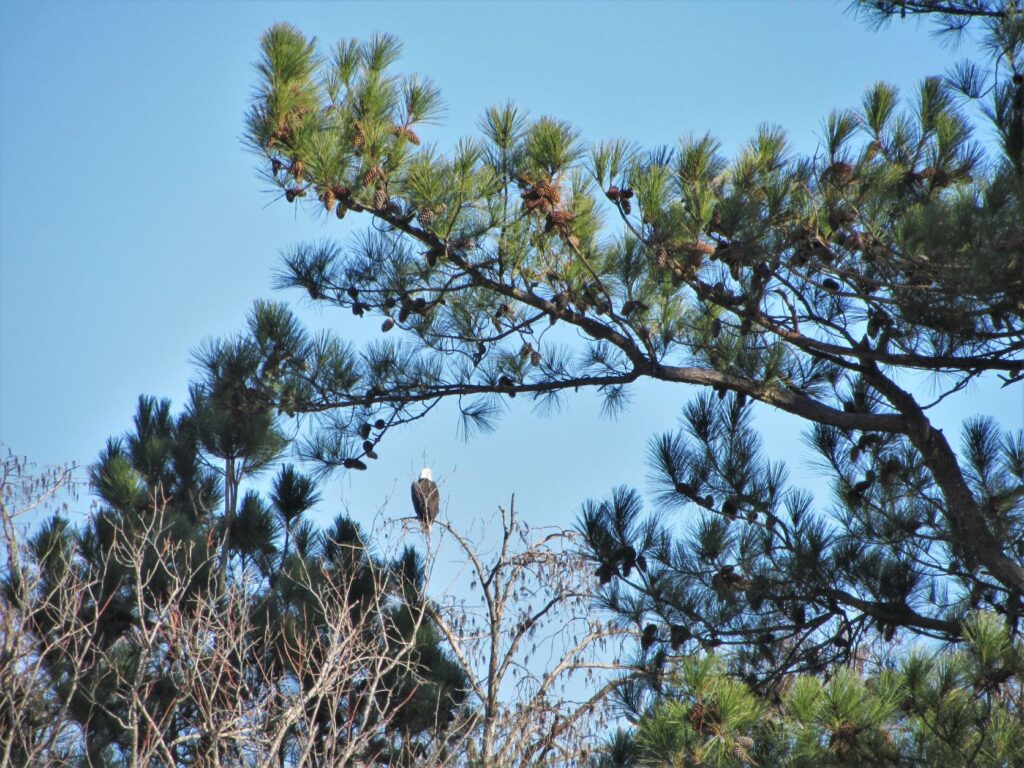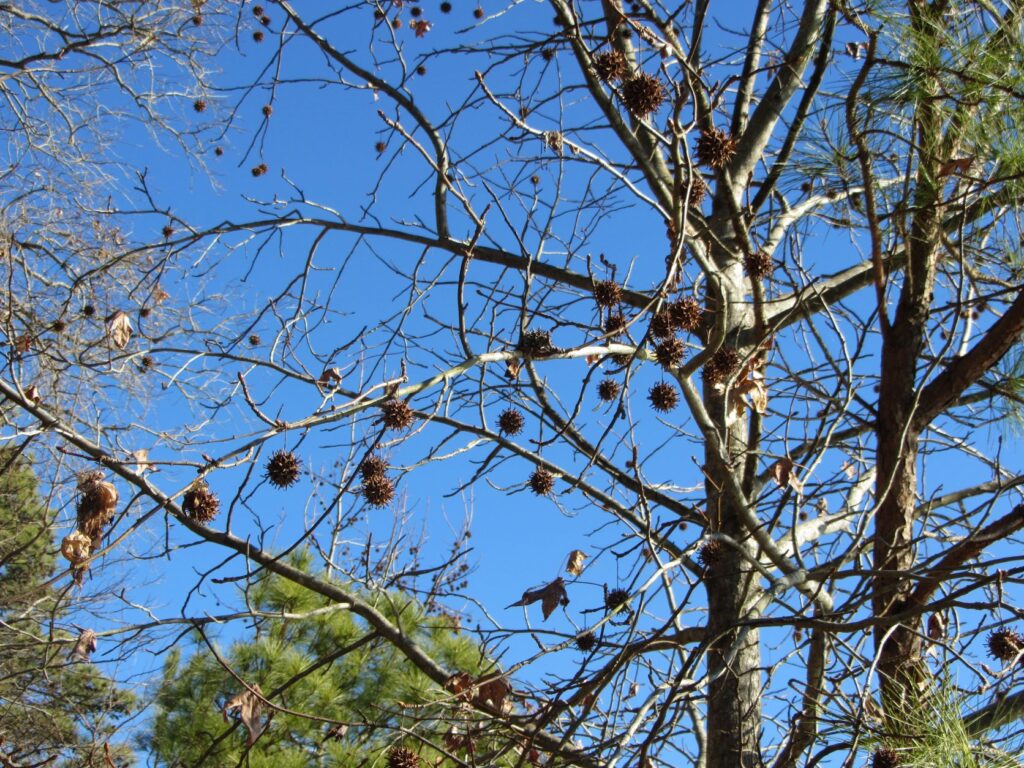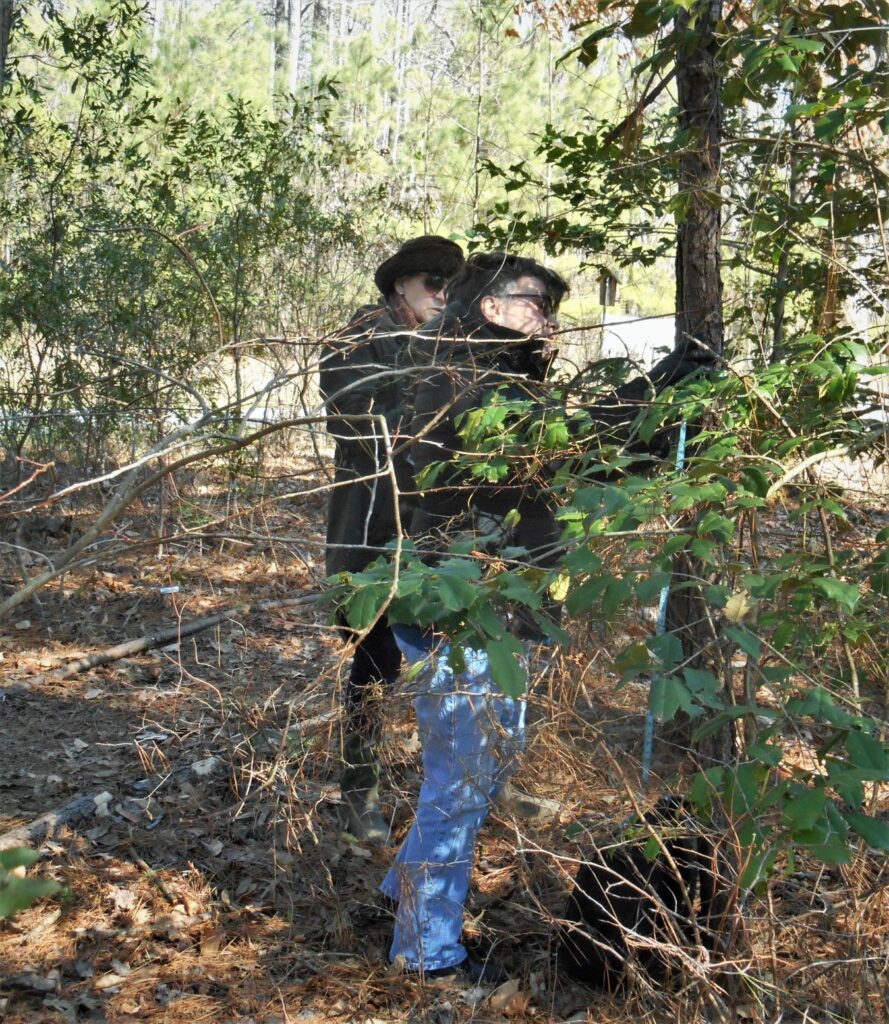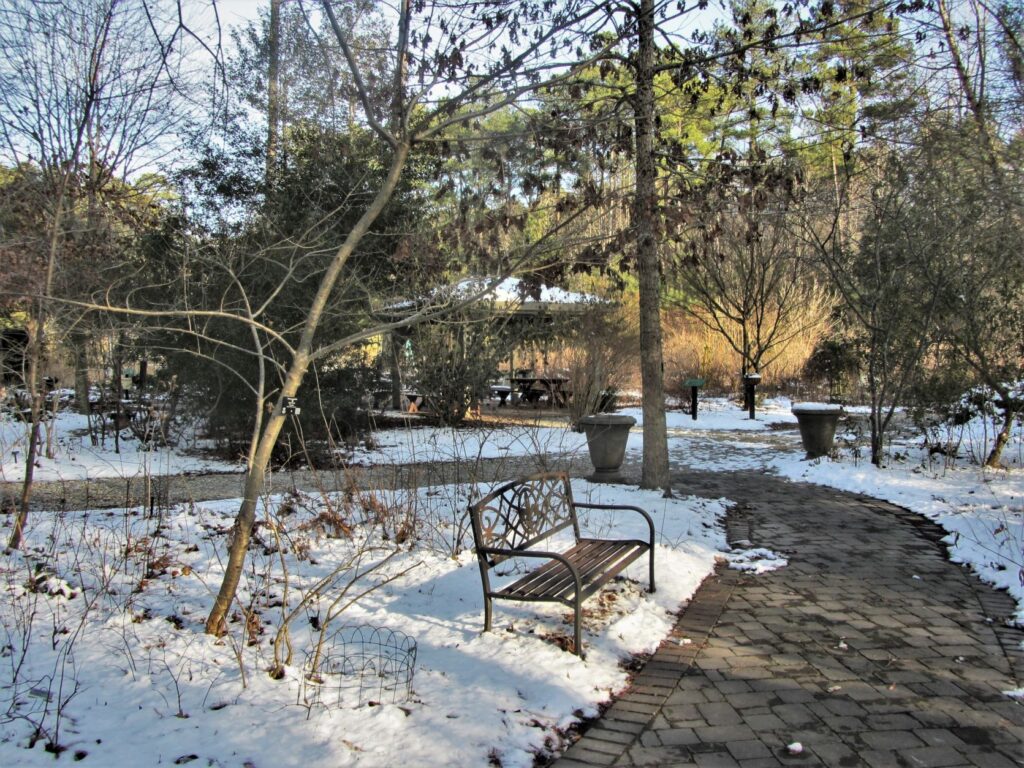Identifying Local Trees in Winter
Recognizing and identifying trees can be a great pleasure. Knowing trees well enough to understand how they fit into the local ecosystem, and how they can be used, allows us to look around at the trees in our community with even greater appreciation. But there are so many trees! How can you learn to identify them without carrying around a heavy field guide?
This was our quandary as my novice Tree Steward colleagues and I began a project to inventory the shrubs and trees within the Williamsburg Botanical Garden in the winter of 2020. We stood there looking around at hundreds of trees, most of them bare, wondering what we had gotten ourselves into.

Members of our Tree Steward team inventory trees at the Williamsburg Botanical Garden in February of 2020. From left: Bill Dichtel, Harry Fahl, Jerry Woodson, and Bob Howell.
We had all spent a morning with Dr. Stewart Ware, Professor Emeritus of Biology and Ecology at William and Mary, learning how to identify bare branches and buds using his “A Winter Twig Key to Common Leafless Dicot Trees in the Williamsburg Area” And, we had walked with him through the winter woods observing trees, and we were all learning about various trees in our classes. Finally, our team met at the garden armed with field guides and magnifiers, ready to apply our new skills.
But Where to Begin?
Sometimes the easiest way to solve a mystery is to sort the information into more manageable clusters. For example, in winter, it is easy to see which trees are evergreen and which are deciduous. We decided to begin with the nearest evergreen pine tree and quickly identified it as a loblolly pine. A field guide helps narrow the range of choices within a type, or genus of tree.

American holly, Ilex opaca, and loblolly pine, Pinus taeda, grow near an old home on Jamestown Island. December 2022
There are several common species of pine trees in our area, so recognizing a pine by its clusters of long needles and its cones is a good start. A field guide helps if you also want to know the tree’s particular species.

Virginia scrub pine can be recognized by its smaller cones and short, twisted needles. It is smaller, overall, than the more common loblolly pine. Its needles have a lemony taste and contain vitamin C. Indigenous Native Americans used every part of the tree and used tea made with the needles medicinally.
This usually involves counting the number of needles in each cluster, noticing the length of the needles and whether they are straight or slightly twisted, and noticing the tree’s bark and cones. The Virginia scrub pine, Pinus virginiana, has short, twisted needles which are edible, usually in bundles of two.

Loblolly pine and bald cypress, Taxodium distichum, grow near Powhatan Creek. Bald cypress, the only deciduous conifer, loses its leaves in winter but still may have a ‘shaggy’ appearance from a distance. December 2022
Recognizing Common Local Trees
The easiest way to recognize trees is by their gestalt, their overall appearance. Each genus has some obvious characteristics that you can learn to recognize from a distance. It may be a tree’s overall shape and structure that you notice first, like the widely spaced branches punctuated with cones, on the very tall, thin trunk of a pine tree.

Sweet gum trees, Liquidambar styraciflua, have distinctive spiky woody fruits that persist for a long time. You may find them under the tree. Some sweet gum trees also have corky ‘wings’ on some twigs and branches. December 2022
There are a limited number of evergreen trees and shrubs in our area that appear over and over again in parks, neighborhoods, and the woods. Once you recognize them, you’ll see them everywhere! First, notice whether the leaves are needles, scales, or broad leaves and whether the leaves appear glossy or dull. That helps narrow down the possibilities further.

Native Southern wax myrtle, Myrica cerifera November 2022
You may notice the ‘knees’ of a bald cypress tree, the red berries on a holly, or the dangling gumballs on a sweet gum tree. Leaves, fruit, bark, nuts, cones, seed pods, and buds all offer clues we can learn to ‘read.’

Bald cypress commonly grows in shallow water or near water. Look for their distinctive ‘knees’ sticking up nearby, which may help provide their roots with air when the tree grows in swamps and standing water. December 2022 at Sandy Bay near Jamestown Island.
You may recognize some trees, like the Eastern red cedar, by their fragrance. Its rich evergreen aroma sings ‘Christmas’ to all of us who grew up with locally harvested red cedar Christmas trees. Although Sassafras trees are deciduous, their twigs and bark still have that distinctive ‘root beer’ aroma in all seasons.

Red cedar, Juniperus virginiana, in December 2022.
Tulip trees retain their woody, tulip-shaped seed pods through the winter. You’ll notice them silhouetted against the winter sky. Redbud trees have long thin papery seed pods that remind me of spring pea pods.

Woody seed pods persist on tulip trees, Liriodendron tulipifera, through the winter. November 2022
Sycamores, with their peeling white bark, have perfectly round fruit balls that dangle from long stems.

Watch for the distinctive bark and perfectly round seed balls to identify the American sycamore, Platanus occidentalis, growing here beside Jones Mill Pond. December 2022
Looking for More Clues
Some trees may not offer any immediate clues once their leaves drop. Young trees, that haven’t yet developed their mature bark, and may be too young to flower or fruit, can be especially hard to recognize. This is when you may need to take a close look at their twigs and buds. A twig is the youngest woody growth on the tree’s branches.

Seed pods linger on native Eastern redbud, Cercis canadensis, through the winter. Flowers, flower buds, and the seeds and pods all are edible. This member of the pea family fixes nitrogen taken from the air into the soil, feeding nearby plants. Bamboo, in the background, is a very tall grass and not an evergreen tree.
Twigs offer lots of clues to those who know what to look for. Take a moment to look at a twig and its new buds closely. Every detail is a clue: color, shape, designs on the wood, and the scars where last summer’s leaves grew.

Notice the leaf scars where last year’s leaves once grew below the terminal bud, which is opening on this oakleaf Hydrangea. The tiny dots in the leaf scar are the vascular bundles. New buds emerge above each leaf scar. Hydrangea quercifolia March 2020
Even the number of vascular bundles within the leaf scar may be important in identifying the family, genus, and species, so have a magnifier handy to study the leaf scar closely.
The ‘dots’ on twigs are the lenticels, openings which allow air exchange through the thin bark so the tree can breathe without its leaves. These dots, and any lines or other changes in texture or color, sometimes offer clues to help with identification.

Lenticels are visible on this American hazelnut twig, along with scale covered buds and emerging male catkins. Corylus americana
After a general observation of the twig’s color and shape, notice whether the leaf scars are positioned opposite one another on the twig, whether they alternate, or whether leaf scars occur in a ring all around a twig. The leaf scars often give up the most clues by their size, shape, position, and marking in and around them. Also, notice whether smaller branches are positioned opposite or alternate with one another. These are all clues needed to ‘key’ an unknown branch to determine its identity.

Flowering dogwood, Cornus florida, has distinct twigs and flower buds.
Finally, notice buds where flowers and leaves will emerge in the spring. Notice their shape, color, and their positions on the older wood. Do they emerge singly, or in a cluster? What sort of scales, if any, cover the bud?

The long, plump terminal buds of red buckeye, Aesculus pavia, make it easy to identify in winter. February 2021
You may be able to identify an unknown tree just by studying its buds, because some, like dogwood and beech, have such distinctive shapes. A cluster of buds at the terminal tip of a branch may indicate an oak tree. The number and position of buds, and other details of their appearance, can sometimes help you determine the exact species of a tree.

Southern witch hazel, Hamamelis virginiana, blooms in winter. Its faded leaves may persist until new ones emerge in spring. February 2022
When looking for clues on an evergreen, remember to examine all sides of the leaf and notice its aroma. The color of the leaf’s underside and the presence and color of any tiny ‘fur’ or hairs on the leaf will help in identifying the tree.

The undersides of broadleaf evergreens often offer important clues. Look at both tops and bottoms, and sniff for fragrance. Persea palustris, swamp bay, December 2022
Document Key Details With Photos
Taking photos of a tree’s details is helpful in eventually identifying it. Take a photo that shows the entire tree from a short distance to reveal its structure. Follow up with photos of the tree’s bark, a twig with buds, and any remaining leaves, fruit, pods or cones. You can refer to these later and compare them to photos you find in books and online.

Swamp bay, Persea palustris, grows as an evergreen understory tree on Jamestown Island. Its leaves smell spicy, like the bay leaves used in cooking. January 2023
Using a Key
You will find a variety of dichotomous keys to help you identify trees in winter and in summer. All lead you through a series of questions designed to help you narrow the choices and finally identify a tree. These can become very complex, depending on how many types of trees are included. Some handy field guides begin with a dichotomous key to help you navigate through the book.
Dr. Stewart Ware has compiled “A Winter Twig Key to Common Leafless Dicot Trees in the Williamsburg Area ( 2023).” He has limited this key in scope to make it more useful for beginners. It includes only deciduous trees. This key will help identify the genus and common name for trees we encounter locally. Use a good field guide to help identify the individual species of trees that belong to large genera like Quercus (oak) or Acer (maple).

River birch, Betula nigra, (background) has distinctive peeling bark. It prefers wet soil. Silky dogwood, Cornus amomum, often has reddish or burgundy new woody growth. It also prefers moist soil and will grow in sun or shade. January 2020
Building a Repertoire
It takes time to build a repertoire of trees that we can easily identify, particularly those we can identify in winter. Once you think you recognize a tree, look for additional clues to confirm your hypothesis. Look at the fallen leaves below its branches. Look for signs of fallen seed pods, cones, or nuts. Notice what other trees grow in the area, especially those that have similar traits. Try to find at least two to three clues to confirm your identification.

Virginia red cedar, J. virginiana, has very distinctive peeling bark when mature. The trunk often looks slightly ‘twisted’. December 2022
A single tree species has one accepted scientific name but may have one or many common names. Botanists know trees by their genus name, like ‘Pinus’ or ‘Quercus’, and by their particular species name, like Pinus taeda or Quercus alba. It is helpful in many ways to know the botanical names of plants, even if we find these names awkward to pronounce. This is the name that botanists agree to use in publishing information about each species.

Southern Magnolia grandiflora may be seen growing in the woods in our area. Evergreen Rhododendron grows in front of it.
When talking with family and friends, we’ll probably use the common name for trees, like ‘loblolly pine’ and ‘white oak.’ We are still using a common name for each tree’s genus (Pinus = pine and Quercus = oak) as well as a descriptor name to distinguish exactly which type of pine or oak if we know it. A problem might develop when a particular species has a collection of different common names. I might be discussing inkberry but you’re discussing Appalachian tea. How do we know whether we’re discussing the same plant unless we both know the botanical name of the plant is Ilex glabra?

Native mountain laurel, Kalmia latifolia, grows in the Virginia woods and may be sited on the banks of rivers and creeks. Look for its leaves and its distinctive bark and contorted stems. December 2022
Several genera which are similar to one another in important ways are grouped into ‘families’ of plants. As we learn more about the trees in our area, we may also learn about these families. For example, we might learn that oak trees and beech trees belong to the same family, Fagaceae, along with chestnuts. All these trees produce strong useful wood, support many species of wildlife, and give us delicious, high-protein nuts that indigenous Native Americans gathered for winter food. They also need similar conditions to grow well.

Old oak trees are among the largest trees in our area. Some species hold on to faded leaves until spring. You can usually find acorns or acorn caps under mature trees to help with identifying the tree’s species. Jamestown Island December 2022.
We learn about trees one at a time. The more we know about each type, the more easily we will recognize trees of the same genus wherever we go. It is fun to recognize trees of all sizes and stages of growth from seedlings to mature trees. The more species we can recognize, the more easily we’ll add new types to our repertoire.

Dr. Donna Ware met with our group and helped us learn to identify woody species in the Williamsburg Botanical Garden. January 2020
From Garden to Arboretum
Our group eventually documented over 150 different woody taxa at the Williamsburg Botanical Garden and Freedom Park Arboretum. We had help. Dr. Donna Ware, retired professor and curator of the Herbarium at William and Mary, assisted our team in identifying many of the native trees, shrubs, and woody vines in the collection. We documented our collection on Plants Map, and the Garden’s and Settlement’s collections were recognized by the Morton Arboretum in December of 2021.

Hazel alder, Alnus serrulata, grows in the swamp at the WBG-FPA. It bears separate male and female flowers on the same plant. January 2020
The collection is now reduced after the removal of the Flowering Shrub Border this summer, but new trees will be added in the coming years. You can find information about all of the various species online. You can also take a virtual Tree Tour of the Garden, to learn more about the collection. When you visit the WBG-FPA you will find many trees labeled with interactive QR tags that you can scan with your phone to learn more about each plant. More Arboretum trees are labeled with QR tags in the nearby Settlement area.
As with so many things, the more you learn, the more connections you’ll notice. Keep adding bits and pieces of information to your understanding of each genus. What are its seeds like? How does it support wildlife? Are any parts of it edible or medicinal? How does it look in spring and summer? What colors do its leaves turn in autumn? Let curiosity be your guide. There are many beautiful books, field guides, and websites that help us build our knowledge about trees.

Tree Steward team members Marion Guthrie and Stephanie Lamb record data about a tree in the inventory.
The more we learn, the more we will come to appreciate the many beautiful trees in our area. And the more we appreciate each species, the more interested we become in nurturing, and perhaps even planting more trees in our community.

The buds of the American beech, Fagus grandifolia, are elongated and thin. faded leaves often persist through the winter. January 2023
Many thanks to Drs. Stewart and Donna Ware for their assistance with editing this post,
and for their help in learning to identify trees in winter.
Appreciation to the Williamsburg Botanical Garden and Freedom Park Arboretum where some of these photos were taken.
All Photos by E. L. McCoy
For more information:
Core, Earl L. and Nellie P, Ammons. Woody Plants in Winter. West Virginia University Press. 1958.
Dirr, Michael A. Dirr’s Encyclopedia of Trees and Shrubs. Timber Press. 2011.
Kershner, Bruce (and others). National Wildlife Federation Field Guide to Trees of North America. Union Square & Company. 2008.
Kirkman, L. Katherine, Claud L. Brown, and Donald J. Leopold. Native Trees of the Southeast. Timber Press. 2007.
Mellichamp, Larry and Will Stuart. Native Plants of the Southeast. Timber Press. 2014.
National Audubon Society. Audubon Society Field Guide to North American Trees: Eastern Region. Knopf. 1980
Sibley, David Allen. The Sibley Guide to Trees. Knopf. 2009.
Wasowski, Sally and Andy Wasowski. Gardening with Native Plants of the South. Taylor Publishing Company. 1994.
Watts, May Theilgaard and Tom Watts. Winter Tree Finder. Nature Study Guild. 1970.
Nix, Steve. “Winter Tree Identification”. Treehugger.
Ware, Stewart. “A Winter Twig Key to Common Leafless Dicot Trees in the Williamsburg Area.” JCCWilliamsburg Master Gardener Association. 2023.





